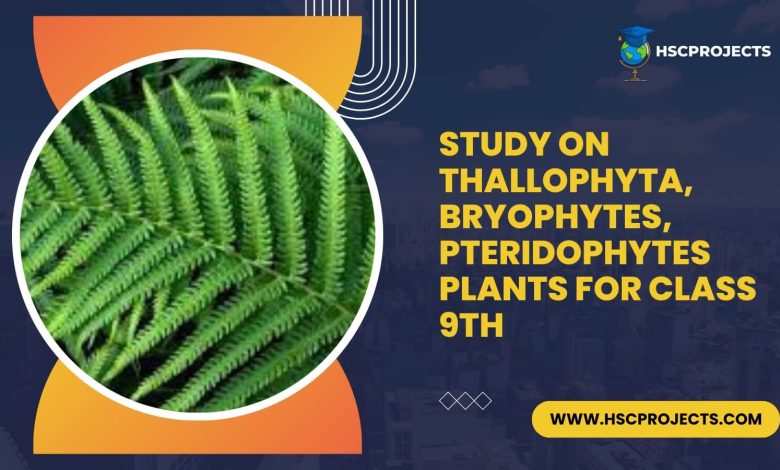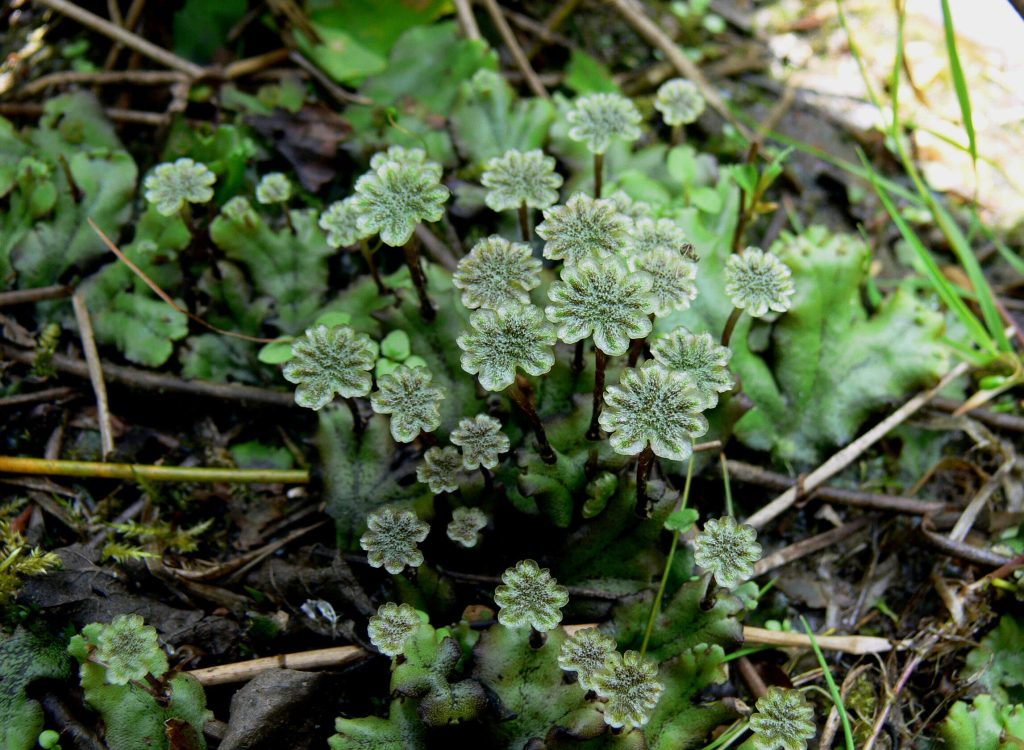
Study On Thallophyta, Bryophytes, Pteridophytes Plants For Class 9th
Acknowledgment
Embarking on the journey of exploring the diverse world of plants through the study of Thallophyta, Bryophytes, and Pteridophytes has been a gratifying and enriching experience. This project would not have been possible without the support and contributions of various individuals and resources.
First and foremost, I extend my heartfelt gratitude to my mentor, [Mentor’s Name], whose guidance and expertise played a pivotal role in shaping the direction of this project. Your encouragement and insightful feedback have been invaluable, and I am grateful for the mentorship that has enhanced my understanding of plant biology.
I would like to express my appreciation to the academic resources, textbooks, and research materials that served as the foundation for this project. The wealth of knowledge provided by these sources laid the groundwork for a comprehensive exploration of Thallophyta, Bryophytes, and Pteridophytes.
Special thanks to [Name of Laboratory Technician/Assistant] for providing assistance during the experimental phases of the project. Your expertise and willingness to share knowledge greatly contributed to the success of the hands-on experiments conducted to deepen our understanding of these fascinating plant groups.
I am also thankful to my peers and colleagues who engaged in discussions, shared insights, and provided a collaborative learning environment. Your enthusiasm and shared passion for the subject enriched the overall learning experience.
Lastly, I extend my gratitude to my family and friends for their unwavering support and encouragement throughout the duration of this project. Your belief in my endeavors has been a constant source of motivation.
This project has been a collective effort, and I am sincerely thankful to everyone who played a role, directly or indirectly, in its successful completion. Your contributions have made this exploration into the world of plants a truly rewarding and enlightening endeavor.
Thank you.
[Your Full Name]Introduction
In the vast symphony of nature, plants stand as both architects and performers, weaving the intricate threads of life that sustain our planet. This project embarks on a captivating exploration of three distinct plant groups: Thallophyta, Bryophytes, and Pteridophytes. Each of these botanical enigmas presents a unique chapter in the narrative of plant evolution, showcasing a myriad of characteristics, life cycles, and ecological roles.
As we delve into the microscopic worlds of Thallophyta, navigating through the simplicity of undifferentiated bodies in algae and fungi, we unravel the fundamental building blocks of these plants. Bryophytes, the non-vascular pioneers of plant life, introduce us to the poetry of alternation of generations, with mosses, liverworts, and hornworts as our guiding verses. Pteridophytes, the vascular virtuosos, take us into the realm of ferns, horsetails, and club mosses, revealing the intricate dance of spores and their indispensable contributions to our ecosystem.
The primary objective of this odyssey is not just to unravel the mysteries held within these plant groups but to foster a profound understanding of their significance. Through the lens of Thallophyta, Bryophytes, and Pteridophytes, we peer into the intricate tapestry of life on Earth, appreciating the roles these organisms play in maintaining ecological balance, preventing soil erosion, and contributing to the breathtaking diversity of plant life.
Accompanied by hands-on experiments that bring theory to life, this project is an invitation to embark on a journey of discovery. It is a celebration of the resilience, complexity, and beauty inherent in the botanical world. So, let us venture forth into the realms of Thallophyta, Bryophytes, and Pteridophytes, unraveling the secrets encoded in their structures and life cycles, and cultivating a deeper appreciation for the silent, yet profound, contributions of plants to the grand tapestry of life.
Thallophyta
- Definition: Thallophyta stands distinguished as a group of plants characterized by the presence of a thallus—an unembellished, undifferentiated body devoid of true stems, roots, or leaves.
- Examples: Within the vast realm of Thallophyta, notable representatives include Spirogyra and Chlamydomonas from the algae family, as well as Rhizopus and Saccharomyces from the fungi lineage.
- Characteristics: The hallmark features encompass the absence of true organs, a simplistic structure, and a reproductive strategy centered around spores.
- Importance: Thallophytes emerge as vital contributors to ecological equilibrium, actively participating in oxygen generation and nutrient cycling.

Bryophytes
- Definition: Bryophytes, classified as non-vascular plants, encompass mosses, liverworts, and hornworts. Their uncomplicated structure conceals a life cycle marked by alternation of generations.
- Examples: Mosses such as Funaria and Sphagnum, liverworts like Marchantia, and hornworts exemplified by Anthoceros stand as archetypes of the Bryophyte realm.
- Characteristics: Characterized by the absence of true vascular tissues, Bryophytes reproduce via spores, with the gametophyte phase dominating their life cycle.
- Importance: In the grand tapestry of nature, Bryophytes play pivotal roles in soil formation, serve as environmental indicators, and contribute to water retention in ecosystems.

Pteridophytes
- Definition: Pteridophytes emerge as a distinctive group among plants, characterized by their vascular nature and reproductive reliance on spores. This category encompasses ferns, horsetails, and club mosses.
- Examples: Within the realm of Pteridophytes, notable representatives include ferns like Pteris and Adiantum, horsetails exemplified by Equisetum, and club mosses represented by Lycopodium.
- Characteristics: Distinguished by the presence of vascular tissues, Pteridophytes boast a well-differentiated sporophyte phase in their life cycle, with reproduction orchestrated through spores.
- Importance: The significance of Pteridophytes extends to their role in combating soil erosion, the ornamental use of certain ferns, and their contribution to the overall diversity of plant life.
Experimental Section
- Experiment 1: Observation of Thallophytes
- Collect samples of algae and fungi.
- Delve into the microscopic world to observe thallus structures.
- Document findings on cell arrangement, presence of chloroplasts, and reproductive structures.
- Experiment 2: Study of Bryophyte Life Cycle
- Acquire moss and liverwort specimens.
- Navigate through the intricacies of gametophyte and sporophyte stages.
- Record observations on the alternation of generations.
- Experiment 3: Examination of Pteridophyte Reproduction
- Gather fern and horsetail specimens.
- Scrutinize spore production and mechanisms of dispersal.
- Explore the pivotal role of spores in the life cycle.
Conclusion
In concluding our botanical expedition into the realms of Thallophyta, Bryophytes, and Pteridophytes, we find ourselves enriched with a deeper understanding of the intricate tapestry woven by these diverse plant groups. The journey has been a captivating exploration of the fundamental building blocks, life cycles, and ecological roles that define the botanical wonders gracing our planet.
Through the lens of Thallophyta, we observed the elegance of simplicity in algae and fungi, recognizing their indispensable contributions to ecological balance through oxygen production and nutrient cycling. Bryophytes, the non-vascular poets, unveiled the delicate dance of alternation of generations, while revealing their roles as indicators of environmental conditions, contributors to soil formation, and guardians of water retention in ecosystems.
Pteridophytes, the vascular virtuosos, took us into the mesmerizing world of ferns, horsetails, and club mosses, showcasing the intricate choreography of spores and their vital role in preventing soil erosion. Their ornamental use and contribution to the rich diversity of plant life added another layer of appreciation for their significance.
The hands-on experiments conducted throughout this project not only brought theory to life but also provided a tangible connection to the subject matter. From observing thallus structures under a microscope to studying the alternation of generations in mosses and liverworts, and examining spore production in ferns and horsetails, each experiment deepened our appreciation for the nuances of plant life.
As we draw the curtain on this botanical exploration, it is evident that the study of Thallophyta, Bryophytes, and Pteridophytes is not merely an academic pursuit but a journey that instills awe and respect for the resilience and complexity inherent in the world of plants. These organisms, often overlooked in their quiet existence, play pivotal roles in sustaining life on Earth.
This project serves as an ode to the marvels of plant life, an invitation to continue our curiosity-driven exploration, and a testament to the profound interconnectedness of all living things. As we step away from this project, may we carry with us a renewed appreciation for the botanical wonders that shape our world, and a commitment to nurturing and preserving the delicate balance of nature.
Bibliography
- Raven, P. H., Evert, R. F., & Eichhorn, S. E. (2005). Biology of Plants. W. H. Freeman and Company. Link
- Campbell, N. A., & Heyden, R. J. (2008). Biology. Benjamin Cummings. Link
- Gifford, E. M., & Foster, A. S. (1989). Morphology and Evolution of Vascular Plants. W. H. Freeman and Company. Link
- Mauseth, J. D. (2008). Botany: An Introduction to Plant Biology. Jones & Bartlett Learning. Link
- Smith, A. R., Pryer, K. M., Schuettpelz, E., Korall, P., Schneider, H., & Wolf, P. G. (2006). A classification for extant ferns. Taxon, 55(3), 705-731. Link
Certificate of Completion
[Student’s Name][Class/Grade Level]This is to certify that I, [Student’s Name], a [Class/Grade Level] student, have successfully completed the project on “Study On Thallophyta, Bryophytes, Pteridophytes Plants For Class 9th.” The project explores the fundamental principles and key aspects of the chosen topic, providing a comprehensive understanding of its significance and implications.
In this project, I delved into in-depth research and analysis, investigating various facets and relevant theories related to the chosen topic. I demonstrated dedication, diligence, and a high level of sincerity throughout the project’s completion.
Key Achievements:
Thoroughly researched and analyzed Project on Study On Thallophyta, Bryophytes, Pteridophytes Plants For Class 9th
Examined the historical background and evolution of the subject matter.
Explored the contributions of notable figures in the field.
Investigated the key theories and principles associated with the topic.
Discussed practical applications and real-world implications.
Considered critical viewpoints and alternative theories, fostering a well-rounded understanding.
This project has significantly enhanced my knowledge and critical thinking skills in the chosen field of study. It reflects my commitment to academic excellence and the pursuit of knowledge.
Date: [Date of Completion]Signature: [Your Signature] [School/Institution Name][Teacher’s/Examiner’s Name and Signature]
In order to download the PDF, You must follow on Youtube. Once done, Click on Submit
Follow On YoutubeSubscribed? Click on Confirm
Download Study On Thallophyta, Bryophytes, Pteridophytes Plants For Class 9th PDF






